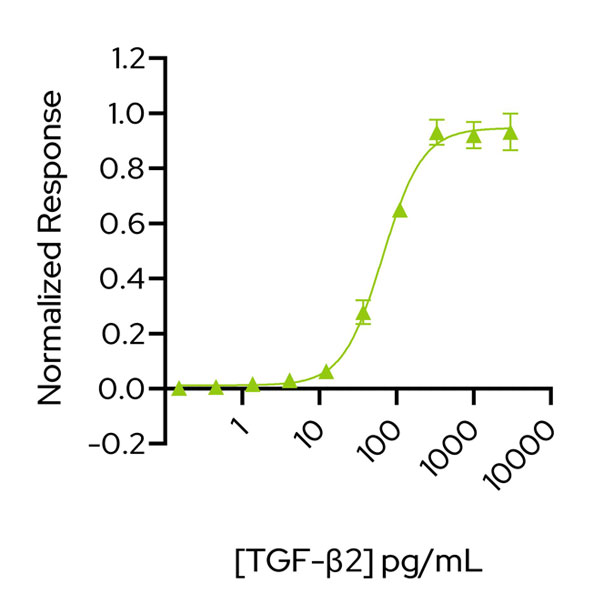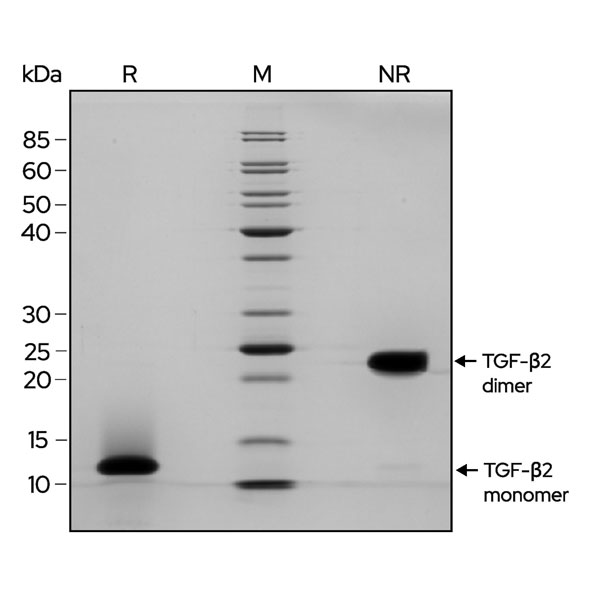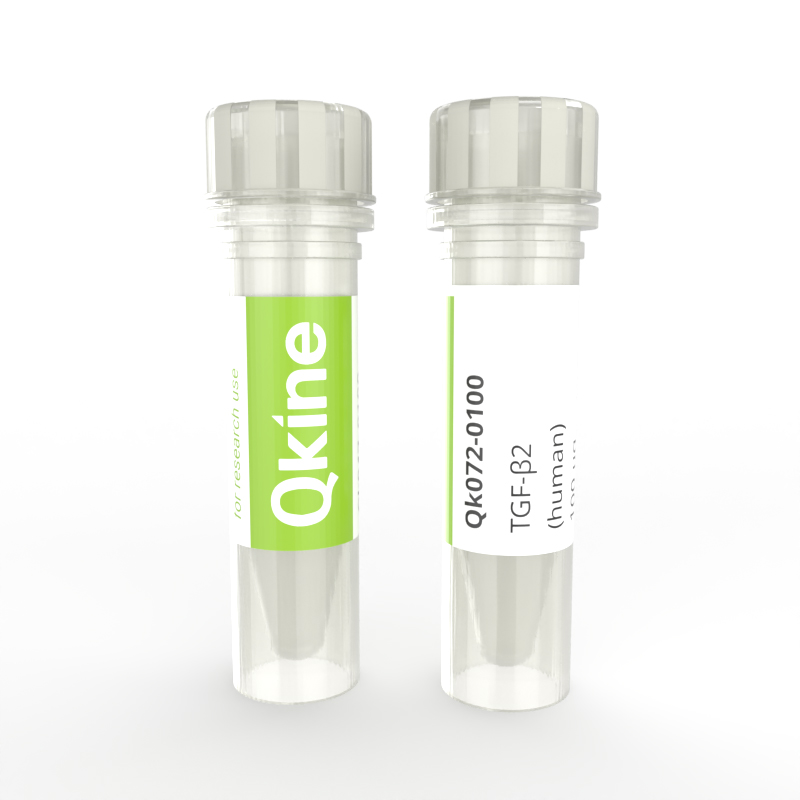Currency
Recombinant human/bovine/porcine TGF-β2 protein (Qk072)
Transforming Growth Factor beta 2 (TGF-β2), part of the TGF-β superfamily, regulates a wide array of cellular processes, including proliferation, differentiation, wound healing, apoptosis, metabolism, embryogenesis, and tissue repair. It is an essential growth factor in many embryonic and induced pluripotent stem cell culture media.
In cell culture, TGF-beta 2 is crucial for directing cell fate, especially in stem cells and differentiation and facilitating wound healing processes. As a modulator of immune responses and a factor in tumour development, TGF-β2’s involvement extends to immunomodulation and interaction within the tumour microenvironment. Its other applications in cell culture include stimulating protein expression and secretion. Overall, TGF-beta 2 emerges as a key player in cellular regulation with diverse biological functions.
TGF-beta 2 is a high purity protein with a molecular weight of 25.4 kDa. This protein is carrier-free and tag-free to ensure its purity with exceptional lot-to-lot consistency. Qkine TGF-beta 2 is suitable for the culture of reproducible and high-quality stem cells and other relevant cells.
Orders are typically shipped same or next day (except Friday).
Easy world-wide ordering, direct or through our distributors.
1000µg will be despatched as 2 x 500µg
Buy online with secure credit card or purchase order or email orders@qkine.com
Bulk and stock reservation available
Summary
High purity human/bovine/porcine protein (UniProt number: P61812)
>98%, by SDS-PAGE quantitative densitometry
Source: Expressed in E. coli
25.4 kDa dimer
Animal-free (AOF) and carrier protein-free
Manufactured in Cambridge, UK
Lyophilized from acetonitrile/TFA
Resuspend in 10mM HCl, prepare single-use aliquots, add carrier protein if desired, and store frozen at -20°C or -80°C
Featured applications
Induced pluripotent stem cell culture and maintenance
Cell proliferation and differentiation
Wound healing and tissue repair
Induction of Epithelial-Mesenchymal Transition (EMT)
Inflammatory response and immune modulation
Stimulation of protein expression and secretion
Transforming growth factor-beta 2
Transforming growth factor beta-2
TGF-beta 2
TGFβ2
TGFB2
TGF-B2
Cetermin
Glioblastoma-derived T-cell suppressor factor
G-TSF
MGC116892
BSC-1
BSC-1 cell growth inhibitor
Polyergin
1. Wakefield, L. et al. Regulation of transforming growth factor-β subtypes by members of the steroid hormone superfamily. Journal of Cell Science 1990, 139–148 (1990). https://doi.org/10.1242/jcs.1990.supplement_13.13
2. Li, J. et al. TGF-β2 and TGF-β1 differentially regulate the odontogenic and osteogenic differentiation of mesenchymal stem cells. Archives of Oral Biology 135, 105357 (2022).
3. Funaki, T. et al. Smad7 Suppresses the Inhibitory Effect of TGF-β2 on Corneal Endothelial Cell Proliferation and Accelerates Corneal Endothelial Wound Closure In Vitro: Cornea 22, 153–159 (2003).
4. Shih, C.-C., Lee, C.-Y., Wong, F.-F. & Lin, C.-H. Protective Effects of One 2,4-Dihydro-3H-Pyrazol-3-one Derivative against Posterior Capsular Opacification by Regulation of TGF-β2/SMADs and Non-SMAD Signaling, Collagen I, and Fibronectin Proteins. CIMB 44, 5048–5066 (2022).
5. Dünker, N. & Krieglstein, K. Targeted mutations of transforming growth factor‐β genes reveal important roles in mouse development and adult homeostasis. European Journal of Biochemistry 267, 6982–6988 (2000).
6. Lee, H. K. et al. TGF-β2 antisense oligonucleotide enhances T-cell mediated anti-tumor activities by IL-2 via attenuation of fibrotic reaction in a humanized mouse model of pancreatic ductal adenocarcinoma. Biomedicine & Pharmacotherapy 159, 114212 (2023).
7. Khan, N., Diaz-Hernandez, M. & Drissi, H. Differentiation of Human Induced Pluripotent Stem Cells (iPSCs)–derived Mesenchymal Progenitors into Chondrocytes. BIO-PROTOCOL 13, (2023).
8. Yamashita, M., Aoki, H., Hashita, T., Iwao, T. & Matsunaga, T. Inhibition of transforming growth factor beta signaling pathway promotes differentiation of human induced pluripotent stem cell-derived brain microvascular endothelial-like cells. Fluids Barriers CNS 17, 36 (2020).
9. Debnath, P. et al. Epithelial mesenchymal transition induced nuclear localization of the extracellular matrix protein Fibronectin. Biochimie 219, 142–145 (2024).
10. Sim, H. J., Kim, M. R., Song, M. S. & Lee, S. Y. Kv3.4 regulates cell migration and invasion through TGF-β-induced epithelial–mesenchymal transition in A549 cells. Sci Rep 14, 2309 (2024).
11. Salminen, A. AMPK signaling inhibits the differentiation of myofibroblasts: impact on age-related tissue fibrosis and degeneration. Biogerontology 25, 83–106 (2024).
12. Oklü, R. & Hesketh, R. The latent transforming growth factor beta binding protein (LTBP) family. Biochem J 352 Pt 3, 601–610 (2000).
13. Miyazono, K., Hellman, U., Wernstedt, C. & Heldin, C. H. Latent high molecular weight complex of transforming growth factor beta 1. Purification from human platelets and structural characterization. J Biol Chem 263, 6407–6415 (1988).
14. De Caestecker, M. The transforming growth factor-β superfamily of receptors. Cytokine & Growth Factor Reviews 15, 1–11 (2004).
15. Zúñiga, J. E. et al. Assembly of TbetaRI:TbetaRII:TGFbeta ternary complex in vitro with receptor extracellular domains is cooperative and isoform-dependent. J Mol Biol 354, 1052–1068 (2005).
Human, bovine, porcine
Frequently used together
Recombinant human EGF protein (Qk011)
Recombinant human FGF-2 145 aa protein (Qk025)
Recombinant human FGF-2 154 aa protein (Qk027)
Recombinant human FGF2-G3 protein (Qk053)
Recombinant human FGF2-G3 145 aa protein (Qk052)
Recombinant human/bovine/porcine IGF-1 protein (Qk047)
Recombinant human/bovine/porcine IGF-1 LR3 protein (Qk041)
Recombinant human PDGF-AA protein (Qk043)
Recombinant human PDGF-BB protein (Qk044)
Recombinant human VEGF165 protein (Qk048)
Recombinant human HGF NK1 protein (Qk013)
Recombinant human/mouse/rat/bovine/porcine BMP-2 protein (Qk007)
Recombinant human BMP-4 protein (Qk038)
Recombinant human IL-1 beta protein (Qk101)
Recombinant human TGF-β3 protein (Qk010)
Bioactivity

TGF-β2 activity is determined using the TGF-β2-responsive firefly luciferase reporter assay. Transfected HEK293T cells are treated in triplicate with a serial dilution of TGF-β2 for 6 hours. Firefly luciferase activity is measured and normalised to the control Renilla luciferase activity. Data from Qk072 lot #204596.
EC50 = 66 pg/mL (2.6 pM)
Purity

Recombinant TGF-β2 migrates as a major band at approximately 25 kDa (dimer) in non-reducing (NR) conditions. Upon reduction (R), only the monomer band at approximately 12.5 kDa is visible. No contaminating protein bands are present.
The purified recombinant protein (3 µg) was resolved using 15% w/v SDS-PAGE in reduced (+β-mercaptoethanol, R) and non-reduced (NR) conditions and stained with Coomassie Brilliant Blue R250. Data from Qk072 lot #204596.
Further quality assays
Mass spectrometry, single species with the expected mass
Endotoxin: <0.005 EU/μg protein (below the level of detection)
Recovery from stock vial: >95%
We are a company founded and run by scientists to provide a service and support innovation in stem cell biology and regenerative medicine. All our products are exceptionally high purity, with complete characterisation and bioactivity analysis on every lot.
Protein background
Transforming Growth Factor beta 2 (TGF-β2) belongs to the TGF-β superfamily, which encompasses TGF-β1, TGF-β2, and TGF-β3. These isoforms collectively regulate a wide array of cellular processes, including cell proliferation, differentiation, wound healing, apoptosis, and metabolism. The TGF-β superfamily signals through the same receptor, eliciting similar biological responses [1- 4].
Overall, the TGF-β family plays pivotal roles in embryogenesis, tissue remodeling, and wound healing. TGF-β2’s significance in developmental processes is evident in mice with TGF-β2 deletions, displaying defects in cardiac, lung, craniofacial, limb, eye, ear, and urogenital systems [5]. It also exerts suppressive effects on IL-2-dependent T-cell growth, potentially enhancing tumour growth by suppressing immunosurveillance [5-6].
In cell culture applications, TGF-beta 2 is extensively employed due to its crucial regulatory roles. It modulates cell proliferation and differentiation by being added to the culture medium, regulating the growth and differentiation of various cell types, especially stem cells, providing a means to control and guide their fate into various cell types such as chondrocytes and epithelial-like cells [7-8]. For wound healing and tissue repair in cell culture models, TGF-beta 2 is utilized to drive cell migration, extracellular matrix production, and overall wound healing processes, creating a controlled environment to mimic conditions associated with tissue repair [3]. TGF-beta 2 is also a key inducer of epithelial-mesenchymal transition (EMT), allowing the study of cellular plasticity and transitions between different cell states [9-10].
TGF-β2’s involvement in immunomodulation, immune response suppression, and its association with tumour development make it valuable in investigating regulatory mechanisms of immune cells and understanding interactions within the tumour microenvironment [9,11]. Additionally, TGF-β2 stimulates the expression and secretion of specific proteins in cell culture, particularly relevant in studies focusing on extracellular matrix components. Researchers may combine TGF-β2 with other growth factors or cytokines to create a more physiologically relevant cellular environment in culture [11].
TGF-β2 is a 25.4 kDa protein composed of two identical 112 amino acid polypeptide chains linked by a single disulfide bond. It forms a latent complex with latency-associated peptide (LAP) and one of the latent TGF-β binding protein (LTBP) family members. This latent complex is stored at the cell surface and in the extracellular matrix. The release of biologically active TGF-β2 involves proteolytic processing of the complex and/or induction of conformational changes by proteins like thrombospondin-1, plasmin, matrix metalloproteases (MMP), or Integrins [12-13].
TGF-β2 signaling involves binding to a complex of the accessory receptor betaglycan (TGF-β RIII) and a type II ser/thr kinase receptor (TGF-β RII) and either TGF-β RI/ALK-5 or ALK-1. This complex activates Smad proteins that regulate transcription, with other Smad-independent pathways contributing to diverse cellular actions [4,14-15]
In summary, TGF-beta 2 plays a crucial role in regulating various cellular processes and is integral to the development of multiple organ systems, exhibiting diverse functions from controlling cell proliferation and differentiation to influencing immune responses and tumorigenesis.
Additional resources
Our products are for research use only and not for diagnostic or therapeutic use. Products are not for resale.



What others are saying
There are no contributions yet.